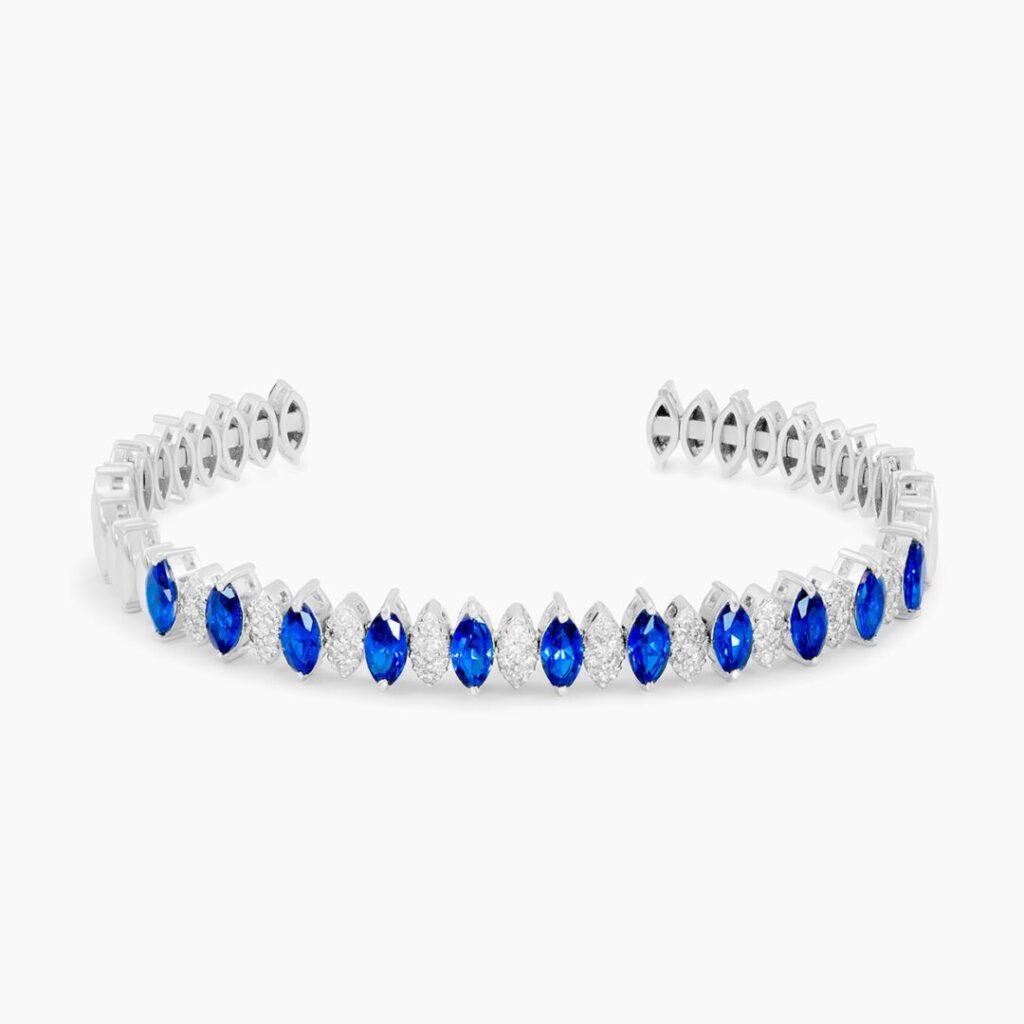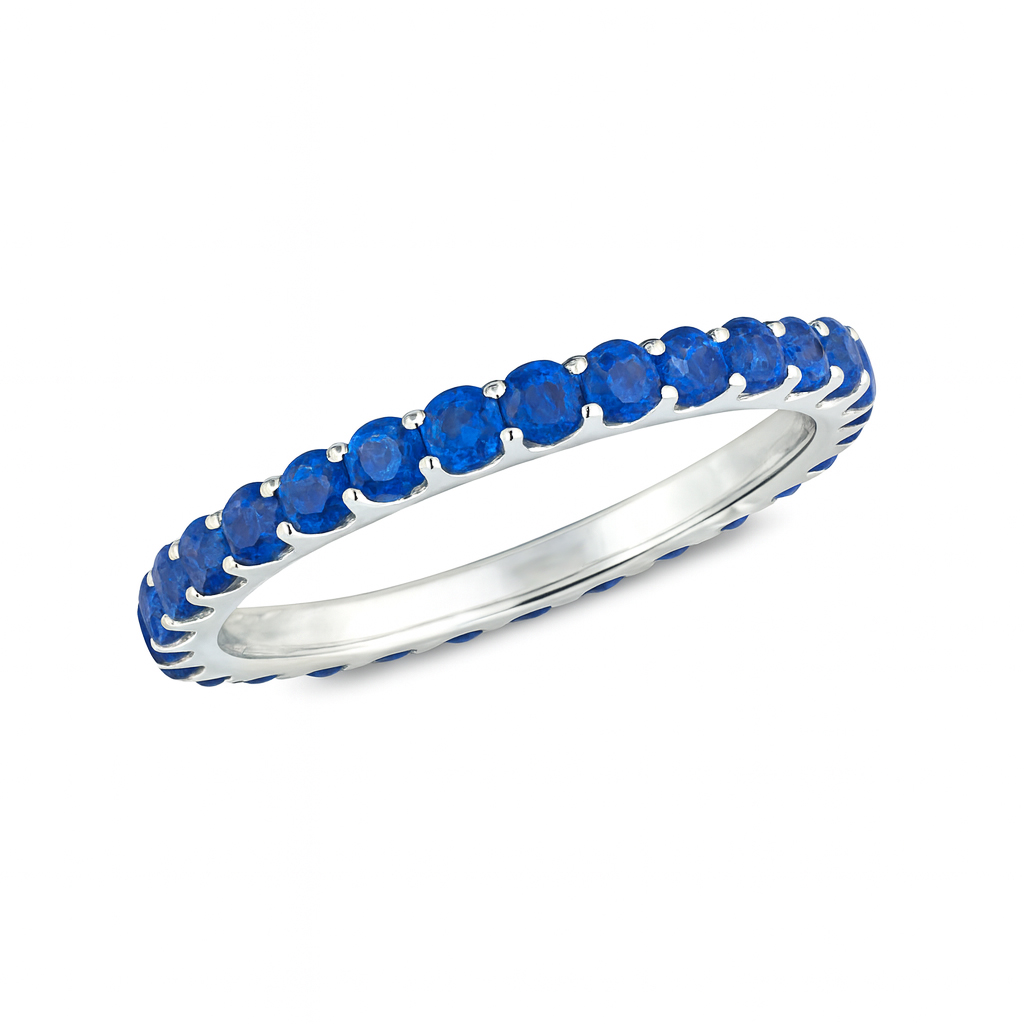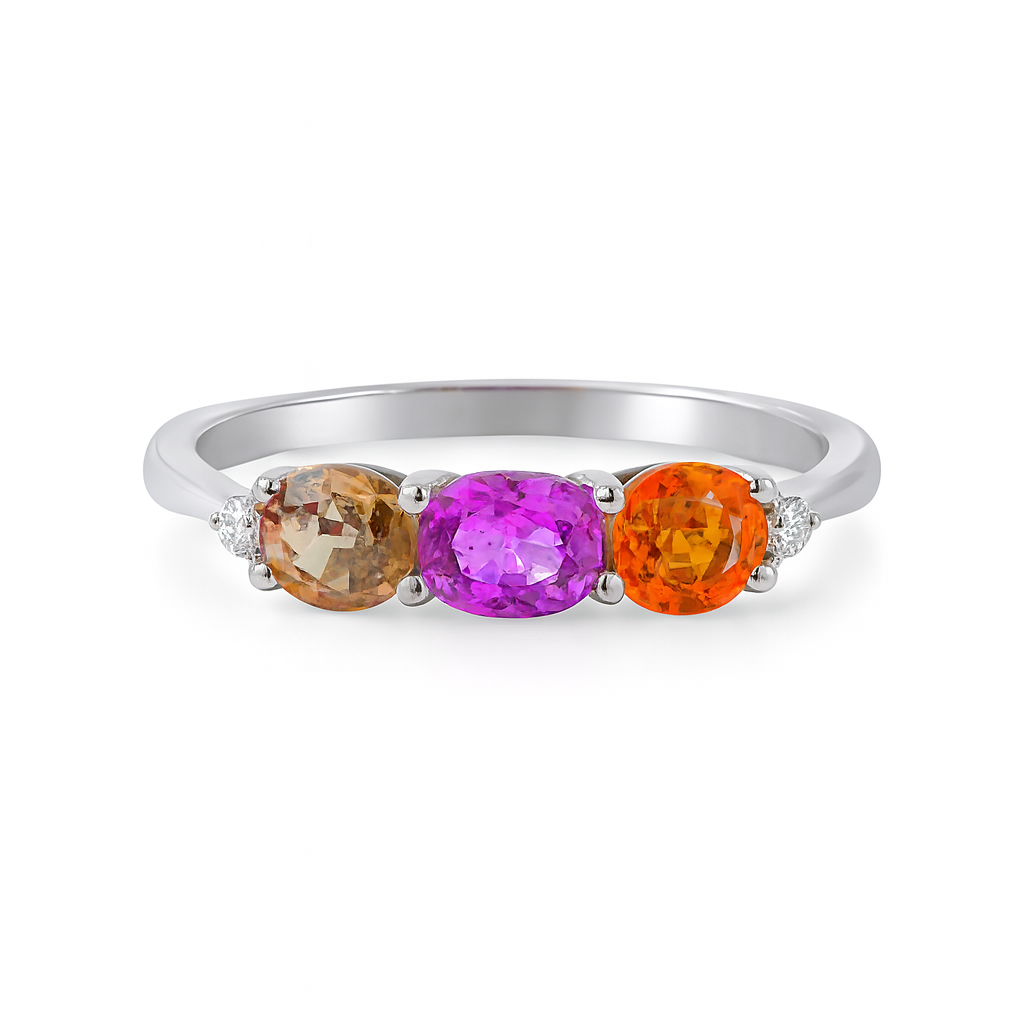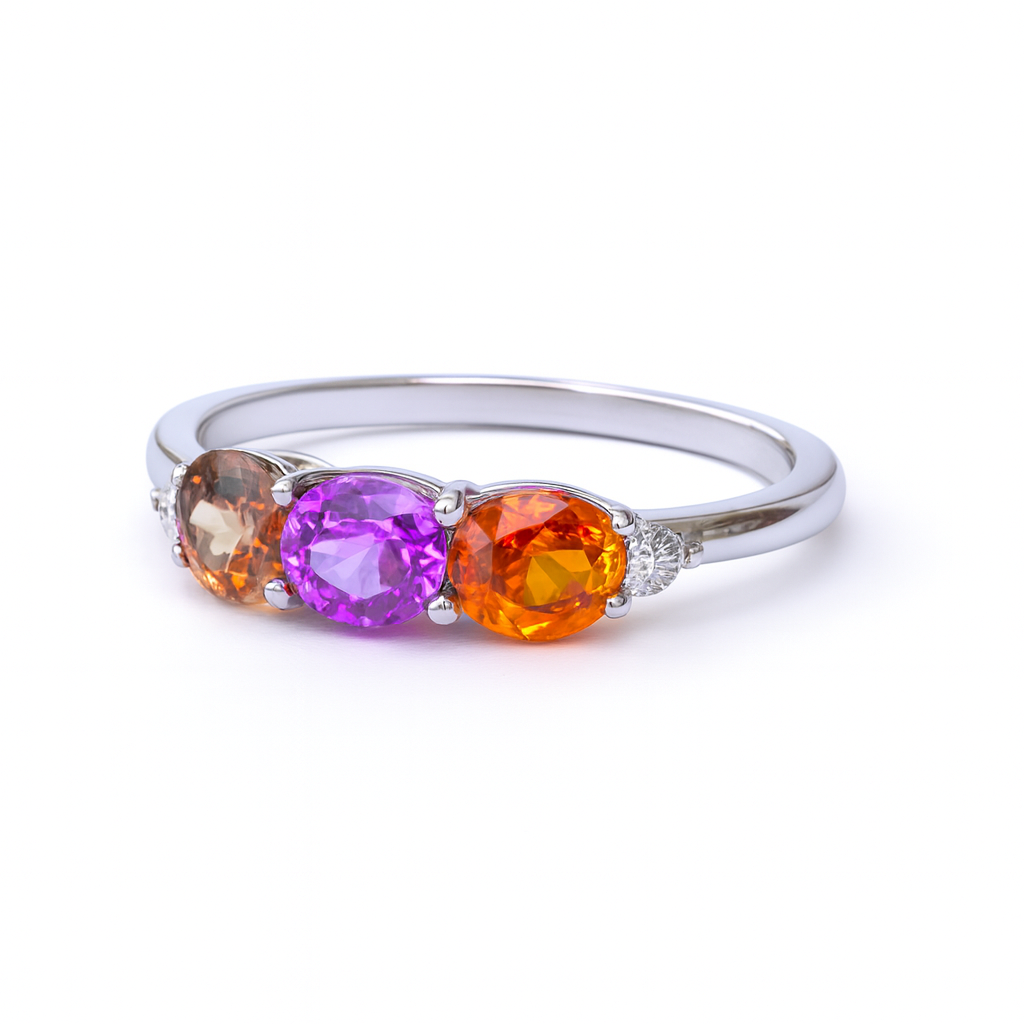Discover the secrets of sapphire grading, buying & investment with this Sapphire Gemstone Guide. Learn how to choose high-quality gemstones with confidence Dubai

What Are Sapphires ?
Sapphires are one of the four most valuable gemstones, along with diamonds, emeralds, and rubies. Although many minerals form stones, only a few become gemstones after cutting and polishing. Sapphires come from the corundum family, and when they appear red, we call them rubies.
What Makes a Sapphire Gemstone "Precious"?
Not all minerals become gemstones. A mineral becomes a gemstone when experts cut and polish it to show its natural shine. In the past, people called gemstones either precious or semi-precious. Even though that’s not an official standard anymore, many still see sapphires as some of the most valuable. Their rich color and strong hardness make them stand out from other stones.
The Hardness and Durability of Sapphires
Sapphires remain popular in fine jewelry because they are very hard. They rank 9 on the Mohs scale, just below diamonds (10) and moissanite (9.5). Their strength makes them great for everyday wear, as they resist scratches better than most gemstones. Industries also use sapphires in infrared optics, scientific tools, and watch crystals because of their durability.
The Fascinating Formation of Sapphire gemstone
The Geological Process Behind Sapphire Formation
Sapphires are more than just beautiful gemstones—they form deep underground over millions of years. Intense heat and pressure change minerals, and as molten magma cools, it helps corundum crystals grow. Only the purest and strongest corundum becomes high-quality sapphire, making each gem a rare creation of time and nature.
The Role of Trace Elements in Sapphire Colors
Sapphires known for their deep blue color, but they come in many shades. Trace elements during their formation cause these colors—iron makes them blue, titanium adds yellow, and chromium creates pink or purple hues. Sometimes, a mix of elements makes sapphires change color or show two colors, making each stone truly one of a kind.
What Makes a Sapphire Different from a Diamond?
Sapphires and diamonds are both minerals, but they differ in how they form and what they're made of. Diamonds form from pure carbon under extreme pressure deep in the earth’s mantle. Sapphires come from corundum, a mineral made of aluminum oxide. Their different crystal structures and hardness levels give each gemstone its own unique qualities.
Nature’s Masterpiece: The Enduring Beauty of Sapphires
Sapphires take millions of years to form, which makes them both rare and valuable. With a hardness of 9 on the Mohs scale, they resist scratches and last for generations. Whether deep blue or a vivid fancy color, sapphires shine as one of nature’s finest gems, loved by collectors and jewelry enthusiasts around the world.
Where Do Sapphires Come From ?
Sapphires mined in various regions across the globe, each deposit producing gemstones with distinct characteristics. From the lush landscapes of Sri Lanka to the rugged terrain of Australia, these dazzling stones originate from some of the most geologically rich locations on Earth.
Top Sapphire-Producing Countries
Sri Lanka
– Known as the "Gem Island," Sri Lanka is famous for its high-quality blue sapphires and rare padparadscha sapphires, which display an exquisite pink-orange hue.
Myanmar (Burma) –
Burmese sapphires highly sought after for their deep, velvety blue tones, often rivaling those from Kashmir.
Kashmir (India) –
The legendary Kashmir sapphires considered some of the finest in the world due to their intense, rich blue color and soft, velvety appearance.
Madagascar –
A rising star in the sapphire trade, Madagascar produces a variety of colors, from classic blues to vibrant pinks and yellows.
Australia –
Known for its deep blue and parti-colored sapphires, Australia remains a key source for commercial sapphire mining.
Thailand & Cambodia –
These Southeast Asian countries are known for producing dark blue and black star sapphires.
Montana (USA) –
The famous Yogo sapphires from Montana boast an intense, cornflower-blue shade, prized for their clarity and brilliance.
Why Sapphires Differ by Region
Sapphires from different locations vary in chemical composition, leading to unique colors, clarity, and overall appearance. The trace elements present in each region's soil, combined with geological conditions, influence the final hue and quality of the gemstone. This is why Burmese sapphires have a different look than those from Australia or Sri Lanka.
Each sapphire, regardless of its origin, carries a story—a journey through time and earth, making it one of the most cherished gemstones in the world.




What Makes a Sapphire gemstone Truly Valuable?
Just like diamonds, sapphires are evaluated based on key quality factors. However, while diamonds are graded by the 4Cs—color, clarity, cut, and carat weight—sapphires follow a different set of priorities. Color reigns supreme in the world of sapphires, making it the most critical factor in determining value.
1. Color: The Defining Feature of a Sapphire
Unlike diamonds, where the absence of color is ideal, sapphires are prized for their rich, vibrant hues. When assessing a sapphire’s color, three aspects come into play:
- Hue – The primary color of the sapphire (e.g., blue, pink, yellow).
- Tone – How light or dark the color appears.
- Saturation – The intensity and purity of the color, with vivid, deeply saturated hues being the most valuable.
Top-tier sapphires exhibit pure, intense colors with minimal secondary hues. For example, a deep royal blue sapphire with strong saturation is far more valuable than one with a grayish or greenish tint.
2. Clarity: Natural Inclusions Don’t Always Diminish Value
Unlike diamonds, sapphires don’t need to be flawless to be highly valuable. In fact, natural inclusions—tiny internal characteristics formed during the gemstone’s creation—are expected. The key is how visible these inclusions are. A sapphire with minor, hidden inclusions can still command a premium price, while one with highly visible flaws may be worth less.
3. Cut: Maximizing Color and Brilliance
The cut of a sapphire doesn’t just enhance its sparkle; it directly impacts how the color is displayed. A well-cut sapphire will reflect light evenly, maximizing the intensity of its hue. On the other hand, poorly cut stones may have a "window"—a dull, transparent area in the center where light escapes rather than reflecting back. Sapphires with large windows tend to sell for less, whereas those with optimal cuts fetch higher prices.
4. Carat Weight: Size vs. Rarity
Sapphires are found in various sizes, but larger, high-quality specimens are exceptionally rare. As a sapphire’s size increases, so does its price—especially if it maintains exceptional color and clarity. A high-quality 5-carat sapphire is significantly rarer and more valuable than five 1-carat sapphires of the same grade.
Final Thoughts
When selecting a sapphire, color should be your top priority, followed by cut, clarity, and carat weight. A well-cut sapphire with deep, vibrant color and minimal visible inclusions will always be a prized possession. Whether for investment or personal enjoyment, a premium-quality sapphire is a timeless gemstone that radiates brilliance, elegance, and rarity.
Are Sapphires Rare ?
Sapphires, in general, are not exceedingly rare, but finding high-quality, untreated sapphires is a different story. While sapphires are mined worldwide, only a small percentage are of gem-grade quality. Most raw sapphires are heavily included, lack vibrant color, or have structural flaws, making them unsuitable for the jewelry market.
1. Untreated Sapphires: The True Rarity
The vast majority of sapphires undergo treatments to enhance their color and clarity. Heat treatment, for example, is a common industry practice used to intensify a sapphire’s hue and minimize visible inclusions. However, untreated sapphires—those that retain their natural color and clarity without any artificial enhancement—are exceptionally rare and highly valuable. These gemstones command premium prices and are sought after by collectors and connoisseurs.
2. Limited and Unstable Sources
Sapphire mining is not as widespread as diamond mining, and many sapphire deposits are found in regions with political or economic instability. Mines must be profitable to remain operational, and if a source yields too few high-quality gems, it may be abandoned. Additionally, ethical concerns and trade restrictions can impact the availability of sapphires from certain regions, making some varieties even harder to obtain.
3. Market Availability vs. True Scarcity
Because treated sapphires dominate the market, it may seem like sapphires are common. However, once you filter out low-grade stones and artificially enhanced gems, the supply of truly exceptional, untreated sapphires becomes incredibly limited. Deep, vivid blues, pure pinks, and striking padparadscha sapphires (a rare pink-orange variety) are especially scarce in their natural state.
Final Thoughts
While commercial-grade sapphires are readily available, investment-quality, untreated sapphires are among the rarest gemstones in the world. If you come across a sapphire with stunning color, high clarity, and no enhancements, you’ve found something truly extraordinary.
Sapphire gemstone Prices: What Determines Their Value?
Sapphires come in a wide range of prices, from affordable to extraordinarily expensive. Their cost depends on several factors, including color, clarity, cut, carat weight, treatment, and origin. Unlike diamonds, where pricing follows a more standardized structure, each sapphire is unique and must be evaluated individually.
1. How Much Does a Sapphire Cost?
The price of a sapphire can range from as little as $20 per carat to well over $450 per carat, with rare, high-quality stones fetching hundreds of thousands of dollars per carat. Several key factors influence sapphire pricing:
Color:
The most valuable sapphires have deep, vibrant hues with excellent saturation. Blue sapphires are particularly sought after, with velvety royal blue and cornflower blue commanding the highest prices.
Treatment:
Natural, untreated sapphires are significantly more valuable than heat-treated or chemically enhanced stones. Most sapphires on the market have undergone some form of treatment, making untreated gems exceptionally rare.
Cut & Shape:
A well-cut sapphire maximizes brilliance and color. Traditional shapes like round, oval, and cushion tend to be pricier due to their high demand.
Carat Weight:
Larger sapphires are rarer, but size alone doesn’t dictate price—quality is just as important. A smaller, high-quality sapphire can be worth far more than a larger, inferior stone.
2. Which Sapphires Are the Most Expensive ?
The highest-priced sapphires are typically deep blue with excellent clarity and saturation. However, flawless pink, yellow, and padparadscha sapphires (a rare pink-orange variety) can also command sky-high prices.
At auction, some of the most valuable sapphires ever sold include:
- The Richelieu Sapphires – A pair of cushion-cut Burmese sapphires totaling 47.54 carats, sold for $8,358,520 at Sotheby’s.
- An Unmounted Burmese Sapphire – A 114.73-carat stone that fetched $7,223,285, setting records for Burmese sapphires.
Sapphire prices continue to rise as demand for high-quality, untreated stones grows, making them a valuable investment for collectors and jewelry enthusiasts alike.
Sapphire Colors: A Rainbow of Possibilities
Sapphires are most renowned for their iconic blue hue, but these gemstones are far from one-dimensional. In fact, they come in a stunning array of colors, making them incredibly versatile for all types of jewelry designs. From vivid pinks to radiant greens, sapphires offer a rich palette for those seeking a gemstone with personality and flair.
1. A Spectrum of Sapphire Colors
While the classic blue sapphire often steals the spotlight, sapphires appear in numerous shades, including:
- Blue: The most famous color of sapphires, ranging from light to deep royal blues, is renowned for its elegance and sophistication. The Royal Blue Sapphire is the pinnacle of sapphire beauty, prized for its rich, intense hue.
- Pink: A gorgeous alternative to ruby, pink sapphires range from pale blush to vibrant fuchsia. The softer hues offer a romantic and gentle vibe, while darker pink sapphires have a bolder, more striking presence.
- Yellow: Often favored by those looking for an alternative to yellow diamonds, yellow sapphires range from pale butter to brilliant canary yellow, with some stones displaying exceptional vibrancy.
- Green: Green sapphires, while rare, provide a beautiful natural color reminiscent of lush forests. Their hues range from soft mossy greens to deeper emerald shades.
- Purple: Purple sapphires, though less common, are equally mesmerizing with their rich, violet tones. Some stones even exhibit a bluish tint, offering a more subtle variation of sapphire beauty.
- Colorless: Similar to diamonds, colorless sapphires offer a pure and clear option, providing a timeless elegance with minimal color influence.
- Black: Bold and sophisticated, black sapphires are prized for their striking, deep black appearance, often used for statement pieces and unique designs.
2. Color-Changing Sapphires: A Magical Transformation
One of the most intriguing types of sapphires is the color-changing variety. These rare stones possess the extraordinary ability to shift colors depending on the lighting conditions. Under natural sunlight, they may appear as one color—often blue or green—only to change to a different hue, like purple or gray, when viewed under artificial lighting. This dramatic transformation makes color-changing sapphires a captivating choice for those seeking something truly unique and dynamic.
3. Blue vs. Yellow: Which Sapphire Reigns Supreme?
When it comes to sapphire color preferences, blue is undeniably the most popular. The blue sapphire’s timeless, regal appeal makes it a top choice for engagement rings and other fine jewelry. However, yellow sapphires have gained significant traction in recent years, particularly as an affordable yet stunning alternative to the pricy yellow diamond. Yellow sapphires, while not as traditional as their blue counterparts, provide a vibrant and cheerful sparkle that suits a variety of personal styles and preferences.
In the end, choosing the "best" sapphire depends entirely on personal taste. Whether drawn to the classic allure of blue or the sunny brightness of yellow, sapphires offer options for everyone, making them one of the most versatile and cherished gemstones in the world.
Different Types of Sapphires: Understanding the Variety
Sapphires, with their stunning array of colors and mesmerizing beauty, come in several different types, each with unique characteristics and qualities. From genuine, unheated sapphires to their synthetic counterparts, there's a sapphire for every taste and budget. Understanding the differences between these types can help you choose the perfect sapphire for your jewelry or investment needs.
1. Genuine Sapphires: Nature's Masterpieces
Genuine sapphires, also known as natural sapphires, are the product of millions of years of geological processes. These stones formed deep within the Earth under intense heat and pressure, and their beauty is entirely a result of natural occurrences. Sapphires are found in many parts of the world, from Sri Lanka to Myanmar, and highly sought after due to their rarity and value.
Unheated sapphires are the most desirable among collectors and connoisseurs because they have remained untouched by human intervention. These sapphires are rare and retain their original colors and properties. Unheated sapphires come in a variety of natural colors, including the classic blue—the most recognized and coveted hue. However, sapphires can also be found in a wide spectrum of other colors such as:
- Yellow: Bright and cheerful, yellow sapphires range from soft buttery hues to intense, vibrant shades.
- Purple: Purple sapphires can be deep and regal, often with undertones of pink or blue.
- Pink: From light pastel pinks to vibrant, fuchsia shades, pink sapphires are a popular choice for romantic jewelry pieces.
- Orange: Orange sapphires are a bold and lively choice, available in varying intensities, from peachy soft tones to fiery deep oranges.
- Brown: Brown sapphires are subtle and earthy, providing a unique, understated elegance.
- Green: Green sapphires have a fresh, natural appeal, with colors ranging from pale mint greens to deeper forest greens.
- Colorless: These sapphires offer a clean, crisp appearance, making them ideal substitutes for diamonds, as they are virtually indistinguishable from them in their clarity and brilliance.
2. Synthetic Sapphires: Lab-Created Wonders
Due to the high cost and rarity of natural sapphires, synthetic sapphires are created in labs as an affordable alternative. These sapphires are manufactured under controlled conditions to replicate the look and feel of natural sapphires. While synthetic sapphires have the same chemical composition and physical properties as their natural counterparts, they are typically less expensive and more readily available.
These lab-created sapphires are ideal for those looking for high-quality stones at a lower price point or for those who prefer a more sustainable option. Despite being man-made, synthetic sapphires can be visually indistinguishable from genuine sapphires and are often used in various jewelry settings.
3. Sapphire with a Combination of Colors
Some sapphires exhibit a combination of colors, making them even more rare and fascinating. These sapphires may feature different hues in different areas of the gemstone, creating a multicolored effect. For instance, a sapphire may have a blue body with orange or pink zones, or it could display a color-changing effect, where the stone shifts from one color to another depending on the light source.
Moreover, These sapphires are often unique and have become particularly popular among those who desire something special and one-of-a-kind. Their distinctive color combinations make them perfect for those who want a gemstone that truly stands out.
Conclusion
Whether you're drawn to the natural charm of unheated sapphires, the affordability and sustainability of synthetic sapphires, or the mesmerizing beauty of sapphires with multiple colors, each type of sapphire offers something unique. Understanding the distinctions between these types can help guide you in choosing the perfect gemstone for your needs, ensuring that you select the sapphire that best matches your personal style and preferences.
Gemological Facts about Sapphire Gemstone
Remarkably Tough and Durable
Sapphires are some of the hardest and toughest gemstones on Earth. They rank 9 out of 10 on the Mohs scale, second only to diamonds. This high hardness makes sapphires very resistant to scratches and everyday wear.
Their durability is why people have valued sapphires for centuries. Unlike softer stones that can lose their shine or get damaged easily, sapphires last a long time. This makes them a perfect choice for engagement rings, wedding bands, or any jewelry you want to wear daily or pass down through generations.
A Rare and Precious Gem
Sapphires are not only beautiful but also quite rare, which makes them valuable. Sapphires up to three carats are common, but stones over five carats are rare and highly sought after. Large sapphires with clear, vibrant color are especially prized by jewelers and collectors.
Moreover, Their rarity adds to their appeal, attracting people who want something unique and valuable. High-quality sapphires with bright color and few flaws are hard to find. Because they are in limited supply, these stones hold great prestige and make a stunning addition to any fine jewelry collection.
Star Sapphires gemstone Get Their Name and Unique Starburst Effect from the Presence of White Silk or Rutile in the Mineral Corundum
Star sapphires are some of the most unique and captivating gemstones. They get their name from the star-shaped pattern that appears on their surface. This amazing effect happens because of tiny needle-like inclusions called white silk or rutile inside the corundum mineral. When light hits the smooth, rounded cabochon cut of the sapphire, these inclusions create a striking six-ray star that seems to move as you turn the stone.
Furthermore, This natural star pattern is what makes star sapphires different from other sapphires. You usually see the six rays clearly under direct light, especially when the stone moves. These inclusions form naturally as the sapphire grows and are not added by any treatment. Star sapphires are always cut into a cabochon shape to show off this beautiful star effect at its best.
Color-Changing Sapphires: A Fascinating Optical Phenomenon
Sapphires possess an intriguing characteristic that sets them apart from many other gemstones: the ability to change color under different lighting conditions. This captivating feature reminiscent of the rare and famous alexandrite, known for its color-changing properties, but sapphires too can display this fascinating phenomenon.
When exposed to different light sources, certain sapphires undergo a dramatic transformation in color. Under natural daylight, these sapphires often appear in their traditional blue hue—a shade that's beloved for its deep, rich elegance. However, when placed under low-light conditions or artificial lighting, the sapphire can shift to reveal violetish blue, purple, or even reddish purples.
Sapphires: A Spectrum of Stunning Colors
Sapphires come in more than just the classic blue—they appear in nearly every color of the rainbow. While blue sapphires are the most popular, you can also find them in pink, peach, purple, yellow, orange, green, teal, and even colorless shades. This wide range makes sapphires one of the most diverse gemstones in the world.
Each color has its own charm. Pink sapphires range from soft pastels to vibrant fuchsia, while green sapphires offer tones from deep forest to bright lime. The rare padparadscha sapphire blends pink and orange in a uniquely beautiful way, making it highly sought after.
Gemstone treatments can enhance these natural colors, making them even more vivid and attractive. Colorless sapphires offer a brilliant diamond alternative, combining exceptional hardness and clarity with a fresh take on a timeless look.
Sapphire gemstone Are Typically Heated at a Temperature of 1700-1900°C
Sapphires are fascinating gemstones, and the process of enhancing their beauty involves heating them at high temperatures. While it may sound intense, sapphires can withstand temperatures as high as 1700-1900°C without melting, making them incredibly durable and resilient. To put this in perspective, silver has a melting point of 962.8°C, and gold melts at 1064°C. In contrast, sapphires only begin to melt under the extreme heat of around 2050°C (or 3722°F), showcasing their exceptional hardness and stability.
This high-temperature heating process, known as heat treatment, is commonly used to enhance the color and clarity of sapphires. When exposed to such intense heat, the sapphire’s natural hues become more vibrant, and any inclusions or imperfections within the stone can be minimized or removed. As a result, the gemstone appears even more breathtaking to behold, revealing its full potential in terms of brilliance and color intensity.
Sapphire gemstone: A Colorful Variety of the Corundum Mineral
Sapphires are a very versatile gemstone, coming in many colors that make them highly admired and sought after worldwide. Contrary to popular belief, sapphires aren’t just the classic blue. They are different-colored varieties of corundum, one of the hardest minerals on Earth.
Sapphires are pleochroic stones.
Sapphires can show different colors when viewed from different angles. This happens because of how they absorb and reflect light. As you move the sapphire or change the lighting, it may reveal new shades, adding depth and charm to the stone.
For example, a blue sapphire might shift between greenish-blue and violetish-blue as you turn it. This color play makes sapphires even more valuable, giving them a lively, ever-changing beauty.
One of the most famous sapphires in history is the royal blue sapphire Prince Charles gave to Lady Diana Spencer in 1981. This beautiful 12-carat gemstone, set in a diamond-studded oval ring, became a symbol of elegance and royalty. Diana received the ring as her engagement ring, and it quickly caught the world’s attention.
The world’s largest and most valuable sapphire, called The Star of Adam, is a stunning blue star sapphire that weighs 1,404 carats. Miners in Sri Lanka discovered it in 2016, and experts estimate its value at over \$100 million.
This gem stands out not just for its massive size but also for its star-like pattern. Natural rutile inclusions create this effect, which is common in star sapphires. Its deep blue color and shining starburst make it a rare and incredible gemstone—one of the most remarkable ever found.











